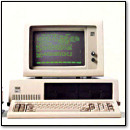Archive for the 'Vintage Computing' Category
High-Res Scan of the World’s First Digital Computer Art
Tuesday, April 9th, 2013
Back in January, I wrote an article about the world’s earliest known figurative computer art for The Atlantic. It it is also likely the world’s first digital computer artwork as well.
(Check out this timeline of computer art history to get an idea where this piece fits in.)
The only known physical record of this circa 1956-58 pin-up diagnostic, which ran on SAGE computer systems, comes from a Polaroid photograph snapped by U.S. airman Lawrence A. Tipton in early 1959. Tipton retains the original print, although it will likely go to a museum soon (more on that when it happens).
 The digital image of the photo used in my Atlantic article was provided by Tipton to a SAGE historian over a decade ago. It was previously the highest-quality version of the photo I had access to, and that posed a few problems. Someone (likely Tipton himself) had hastily retouched the image, removing various scratches, and it was not presented in a high enough resolution to examine in detail.
The digital image of the photo used in my Atlantic article was provided by Tipton to a SAGE historian over a decade ago. It was previously the highest-quality version of the photo I had access to, and that posed a few problems. Someone (likely Tipton himself) had hastily retouched the image, removing various scratches, and it was not presented in a high enough resolution to examine in detail.
To remedy that, Tipton was kind enough to make a high resolution scan of the original print and mail it to me on CD-ROM back in February. With his permission, I am providing the high-resolution scan of the pin-up console photo unretouched and unmodified below so that (a) others may learn from it and (b) to ensure that our only record of this important achievement in art is not lost.
[ Continue reading High-Res Scan of the World’s First Digital Computer Art » ]
[ Retro Scan of the Week ] Star Dot Matrix Printer
Monday, April 8th, 2013 The Star Micronics Delta-10 Dot Matrix Printer: Mouse with Machine Gun
The Star Micronics Delta-10 Dot Matrix Printer: Mouse with Machine Gun
My family owned this exact printer. In fact, I think it’s still sitting in my parents’ attic as we speak. If I’m not mistaken, we used it with our Apple IIe system — the one my dad built from a bare circuit board and a set of cloned ROM chips (much like the one in this 2006 VC&G post).
It’s probably the first printer I ever saw in action, likely before I could even walk. I can recall crawling under our computer desk (the printer was on the floor beneath it for some reason) and watching it print out whimsical banners and calendars from a program like Broderbund’s The Print Shop.
But what I remember most about it, of course, was the sound it made: like a screeching robot mouse spraying lead into tractor-feed paper with a tiny machine gun. Like any dot matrix printer, once you hear one in action, the sound will never leave you.
Those were the days.
Of course, I was still using a dot matrix printer until the early 1990s, so I am pretty much scarred for life. Mice everywhere.
Discussion Topic of the Week: What was the first printer you ever owned?
Revisiting Hotline, the 1990s Internet BBS Platform
Tuesday, April 2nd, 2013Back in the mid-late 1990s, an Internet-based BBS platform called Hotline sprung up and quickly spread throughout the Macintosh community. It was basically a client/server BBS software suite that allowed for multi-user chat, file transfers, and message boards.
By the early 2000s, though, Hotline had mostly died out. Today, only a handful of servers remain. But guess what? You can still connect to them — on Windows or a Mac. A new article I wrote for Macworld, “Hotline Revisted,” tells you how.
Have fun. Remember to be kind to the Hotline veterans when you visit.
Predicting the Smartphone in 1989 — as the Smartwatch
Monday, March 25th, 2013
While researching my slideshow on smartwatch history for TechHive last month, I came across an interesting 1989 letter to Computerworld magazine. It was a response to an earlier article in the publication about the inevitability of a wearable watch-sized microcomputer.
I find the letter prescient because its author imagines the consequences of walking around with a full-blown networked computer on your wrist. And he was right about his predictions in every regard except one: instead of computers on our wrists, we’re walking around with computers in our pockets. In other words, smartphones.
But that’s the nature of predicting the future. You can often get the general trends correct without knowing the details. Nobody in 1989 had any idea that the cell phone, instead of the watch, would first become the vehicle through which we’d wear tiny networked computers on our persons almost every hour of the day.
[ Continue reading Predicting the Smartphone in 1989 — as the Smartwatch » ]
[ Retro Scan of the Week ] Apple II Box for C64
Monday, March 25th, 2013 A scene from one of Benj’s recent nightmares.
A scene from one of Benj’s recent nightmares.
Hey mime! Yeah, you! Stop stealing my $599 Mimic Spartan Apple II+ compatibility box for the Commodore 64. I need it to open up a whole new world of hardware and software.
Just for a second, imagine if I could add these features to my Commodore 64: Apple II+ hardware and software capabilities, 64K RAM expansion, four software selectable Commodore 64 cartridge slots, non-dedicated 8-bit parallel port, and standard audio cassette deck capabilities for my C-64. Yep, all of that!
The suggested retail value of comparable products offering only these capabilities is over $2,200.00*. But the Spartan gives me much, much more, mime! Oh yes. By building on my investment in my Commodore 64 — an excellent introductory computer — I create a whole new system with both C-64 an Apple II+ capabilities.
There is a whole other world out there! And if you’d just give it back, a huge selection of Apple II+ hardware and software would be mine to explore. Call toll free for the Spartan dealer nearest you.
* Burp.
Discussion Topic of the Week: Open Discussion: Whoever posts a question first gets to decide what we’ll talk about this week.
—
See Also: MacCharlie’s FrankenMac (2013)
Benj’s Macworld and TechHive History Roundup
Saturday, March 23rd, 2013

I last updated you on my Macworld work back in January. Since then, I’ve been busy writing more historically-minded pieces for the site as well as its sister site, TechHive. Below you’ll find a list of the ones I haven’t mentioned yet on this blog in convenient digest form.
- 01-30-2013- The Little-Known Apple Lisa: Five Quirks and Oddities
- 02-08-2013 – The History of Electronic Board Games
- 02-11-2013 – The Mac Color Classic, 20 Years Later
- 02-16-2013 – Abandoned Apples
- 02-18-2013 – Evolution of the Smartwatch
- 03-01-2013 – The Evolution of Apple Pointing Devices
- 03-15-2013 – Teach Your Old iPod New Tricks
- 03-22-2013 – Apple’s Five Most Important Displays
Phew. I’ve been busy! Of those eight pieces, the Apple Lisa one can’t be missed. Plenty of interesting little-known history there. The Mac Color Classic and Abandoned Apples pieces are some of my favorites as well.
I’m not sure, but I get the feeling from the lack of comments on my Apple-related posts that not many Apple or Mac fans visit VC&G. Not quite sure why that is, but if you’re out there, let me know.
[ Retro Scan Special ] Buying from Epic Games in 1996
Monday, March 18th, 2013 Epic MegaGames purchase invoice in January 1996.
Epic MegaGames purchase invoice in January 1996.
You’re looking at a rare physical artifact from the twilight of shareware’s golden age.
Way back in 1996, when Gears of War maker Epic Games still went by “Epic MegaGames,” I ordered a few registered copies of its shareware games through CompuServe.
Since it was a special buy-and-download deal (very unusual in 1996), I didn’t receive copies of the games themselves on disk. Instead, Epic mailed an invoice, copies of the games’ instruction manuals (which have been displaced from this set, or else I would have scanned them too) and a shareware demo disk from Epic partner Safari Software.
[ Continue reading [ Retro Scan Special ] Buying from Epic Games in 1996 » ]
Fix the DMCA to Preseve our Cultural Heritage
Friday, March 15th, 2013Just up on The Atlantic.com is an op-ed I wrote that argues for repealing the anti-circumvention section of the DMCA because it threatens the preservation of our cultural heritage.
Perhaps by now you’ve heard about the campaign to repeal the anti-circumvention section (1201) of the Digital Millennium Copyright Act. This most recent challenge to the DMCA arose from a recent decision by the Librarian of Congress to discontinue a three-year exemption that made cell phone unlocking legal.
Opponents of the DMCA anti-circumvention provision claim that the law threatens consumer control over the electronic devices we buy, and they’re right. But the stakes are much higher than that. Our cultural history is in jeopardy. If the DMCA remains unaltered, cultural scholarship will soon be conducted only at the behest of corporations, and public libraries may disappear entirely.
That’s because the DMCA attacks one of the of the fundamental pillars of human civilization: the sharing of knowledge and culture between generations. Under the DMCA, manmade mechanisms that prevent the sharing of information are backed with the force of law. And sharing is vital for the survival of information. Take that away, and you have a recipe for disaster.
Share my article. Spread the word. It’s time to fix the DMCA.
—
“DRM is a problem like mold is a problem, like fire is a problem. What distinguishes it, of course, is that it’s a man-made construct, which makes it seem really sad.” – Jason Scott, Archivist at The Internet Archive









